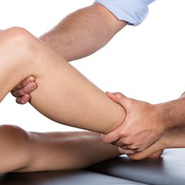Physiotherapy
What is Physiotherapy?
The various therapeutic applications of physiotherapy can help us improve, restore or maintain our ability to move and function. Physiotherapy can also help alleviate symptoms. The term mainly refers to so-called movement therapy (formerly referred to as "physical therapy"), which can only be performed by trained physiotherapists. It provides a viable alternative or supplement to surgical or medical treatment.
Physiotherapy includes both active and passive forms of therapy. In active therapy, the patient performs various exercises that can help prevent or alleviate complaints. With passive therapy, this is done through treatment by a therapist.
What is Physiotherapy used for?
Physiotherapy is mainly used for prophylaxis, therapy and rehabilitation. In order to prevent illnesses or injuries, incorrect posture should be avoided. We should train our own body perception so that we can, for example, recognise bad posture when sitting. This is an easy way for each of us to do something to improve our health.
Physiotherapy is also used in inpatient and outpatient treatment. It can support the healing process of orthopedic disorders and improve our quality of life.
Finally, physiotherapy can help improve rehabilitation after longer illnesses or accidents. Patients who have suffered from a stroke, for example, can use physiotherapy to increase their mobility and motor skills and make it easier for them to return to their normal lives.
These are some of the main objectives of physiotherapy:
- Supports metabolism and circulation
- Provides relief from pain, or at least reduces it
- Increases endurance and strength
- Improves coordination and mobility
These fundamental goals do not exist separately, but are often mutually dependent.
Physiotherapy is not only used in case of illness, but also in wellness. It can help improve mental and physical wellbeing. It can help us take a pleasant break from our everyday lives!

What are the different forms of Physiotherapy?
In orthopaedics, manual therapy, manual lymph drainage and device-supported therapy are commonly used forms of treatment.
Manual therapy means that the physiotherapist uses certain mobilisation exercises and hand movements. Among other things, this can improve the mobility of our joints and help rebuild cooperation with our nerves and muscles.
Manual lymphatic drainage is another frequently used method. It can be used to stimulate the decongestion of swollen tissue. Such swelling occurs when our body's lymphatic system is damaged or overloaded and the lymphatic fluid can no longer be completely evacuated. In this case, the therapist stimulates the flow of lymph and the activity of the lymphatic nodes in the body with rhythmically pumping or circular movements.
With device-supported therapy, various pulling devices and pieces of medical exercise equipment are used to improve the patient's mobility and strength. Ultimately, active cooperation between the therapist and the patient is always decisive for successful therapy.
